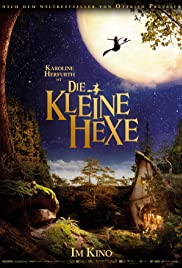
THE LITTLEWITCH/ DIE KLEINE HEXE
Germany/Switzerland, 2018, 103 minutes, Colour.
Karoline Herhurth.
Directed by Michael Schaerer.
The film is inspired by German folklore concerning Walpurgis Night. The night from April 30 to May 1 is called Hexennacht ("Witches' Night"), and witches are reputed to hold a large celebration on the mountain peak Brocken. The film does not specify the location of the witches' gathering, but the mountain peak depicted is implied to be the Brocken (also called Blocksberg), the highest peak of the Harz mountain range. The mountain is located in Saxony-Anhalt. IMDb.
This is a German fairytale from a popular German author. It is a live action fairytale rather than animation, although it relies very strongly on make up, with touches of the grotesque, especially for the group of witches. There is also a talking raven. And, for special effects, there are all kinds of spells, many of them comic, many of them to do with nature.
The focus is on the Little Witch (no personal name), turning 128 years old, living alone with her friend and critic, a black raven. She wants to be part of the life of the other witches in the area, venturing to the celebration of Walpurgis night, the joy and dancing. However, she is confronted by the other witches, court is held, she makes some justifications but, as a punishment, she is required to carry home the huge volume of witches’ lore, study it and come back in a year’s time.
The action of the film is her learning, her venturing out, going to a fair, encountering two young children and befriending them, helping them against a bully, actually having compassion for the bully who is treated badly by his father, casting a spell on the father’s bowling ball, the father reconciled with his son. One of the witches, vengeful, visits the Little Witch, tries to detect the human visitors, keeps a notebook, spies on the Little Witch for the year and brings all this evidence against her when she goes to the court with the witches.
There is some tantalising dialogue about what it is to be a good which casting bad spells and a bad which casting good spells.
This is a film which can be designated for the family but, of course, be of major interest for young girls rather than for their brothers.
The sets are lavishly designed, the photography often beautiful, and a recreation of German village life. The Swiss director has had long experience as a film editor.